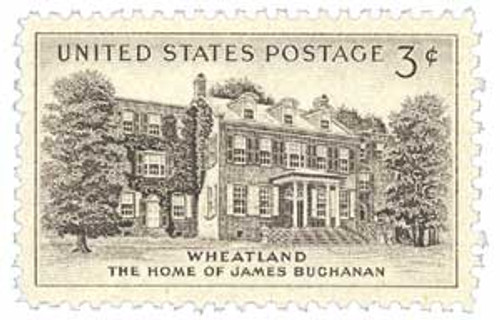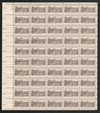
1956 3¢ Wheatland
# 1081 - 1956 3¢ Wheatland
$0.35 - $28.00
U.S. #1081
1956 3¢ Wheatland
1956 3¢ Wheatland
Issue Date: August 5, 1956
City: Lancaster, Pennsylvania
Quantity: 125,475,000
Printed by: Bureau of Engraving and Printing
Printing Method: Rotary Press
Perforations: 11 x 10 ½
Color: Black brown
City: Lancaster, Pennsylvania
Quantity: 125,475,000
Printed by: Bureau of Engraving and Printing
Printing Method: Rotary Press
Perforations: 11 x 10 ½
Color: Black brown
U.S. #1081 pictures Wheatland, the home of U.S. President James Buchanan. Built in 1828 in Lancaster, Pennsylvania, the Wheatland mansion is an outstanding example of federal architecture. The mansion was constructed by wealthy lawyer and banker William Jenkins. Jenkins named the estate “The Wheatlands,” after the rich fields of wheat that surrounded the property. In 1848, James Buchanan (1791-1868), at that time the U.S. Secretary of State, purchased the 22 acres of land, mansion, and other attached properties for $9,000. Buchanan shortened the name to “Wheatland.”
Wheatland is considered an important architectural period piece and a historical shrine. Remarkably preserved, the mansion is open for tours for much of the year.
James Buchanan (1791-1868)
15th President of the United States
15th President of the United States
James Buchanan’s presidency began with his involvement in a Supreme Court case, and ended with a nation torn in two. From the Dred Scott decision in the United States Supreme Court, to the secession of seven Southern states by the end of his term, Buchanan is permanently linked to the most bitter divide in the country’s history – the Civil War.
Buchanan was labeled by many a “doughface” – a Northerner with Southern sympathies. Formal and stately in manner, Buchanan was unable to grasp the passions dividing the nation. The division would overwhelm him; he refused to consider the use of force to preserve the Union even as Confederate troops were gathering. He urged compromise, but the two factions were long past talking, and his proposed solutions were ignored by both parties.
Buchanan left office powerless, and the divided nation was on the brink of more than four tragic years of war. He returned to Wheatland after his presidency, and died there three years after the end of the American Civil War.
U.S. #1081
1956 3¢ Wheatland
1956 3¢ Wheatland
Issue Date: August 5, 1956
City: Lancaster, Pennsylvania
Quantity: 125,475,000
Printed by: Bureau of Engraving and Printing
Printing Method: Rotary Press
Perforations: 11 x 10 ½
Color: Black brown
City: Lancaster, Pennsylvania
Quantity: 125,475,000
Printed by: Bureau of Engraving and Printing
Printing Method: Rotary Press
Perforations: 11 x 10 ½
Color: Black brown
U.S. #1081 pictures Wheatland, the home of U.S. President James Buchanan. Built in 1828 in Lancaster, Pennsylvania, the Wheatland mansion is an outstanding example of federal architecture. The mansion was constructed by wealthy lawyer and banker William Jenkins. Jenkins named the estate “The Wheatlands,” after the rich fields of wheat that surrounded the property. In 1848, James Buchanan (1791-1868), at that time the U.S. Secretary of State, purchased the 22 acres of land, mansion, and other attached properties for $9,000. Buchanan shortened the name to “Wheatland.”
Wheatland is considered an important architectural period piece and a historical shrine. Remarkably preserved, the mansion is open for tours for much of the year.
James Buchanan (1791-1868)
15th President of the United States
15th President of the United States
James Buchanan’s presidency began with his involvement in a Supreme Court case, and ended with a nation torn in two. From the Dred Scott decision in the United States Supreme Court, to the secession of seven Southern states by the end of his term, Buchanan is permanently linked to the most bitter divide in the country’s history – the Civil War.
Buchanan was labeled by many a “doughface” – a Northerner with Southern sympathies. Formal and stately in manner, Buchanan was unable to grasp the passions dividing the nation. The division would overwhelm him; he refused to consider the use of force to preserve the Union even as Confederate troops were gathering. He urged compromise, but the two factions were long past talking, and his proposed solutions were ignored by both parties.
Buchanan left office powerless, and the divided nation was on the brink of more than four tragic years of war. He returned to Wheatland after his presidency, and died there three years after the end of the American Civil War.









